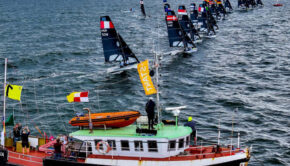Match Racing Brain Food
Published on April 20th, 2016
by Dave Perry, Chairman, US Sailing Match Racing Committee
To help you understand the ways the 2016 Test Rules will change the way the game is played, I have put together a powerpoint highlighting 30 or so scenarios where the outcome is different under the Test Rules. Additionally, I have written a paper called A Different Game that goes into depth on how a boat’s tactics will be different, as well as how umpires may need to change their positioning and observations. Note, these two papers have been slightly revised in March.
These items can be found, along with the text of the 2016 Test Rules and several other World Sailing supporting documents, on the US Sailing Match Racing website under The 2016 Test Rules for Match Racing.
Here are excerpts from the powerpoint and A Different Game illustrating how the game is significantly different at the windward mark due to test rule 18.3: Mark-Room, Tacking or Gybing.
Test Rule 18.3, Tacking or Gybing
When an inside overlapped right-of-way boat must change tack at a mark to sail her proper course, until she changes tack she shall sail no farther from the mark than needed to sail that course. Rule 18.3 does not apply at a gate mark or a finishing mark and a boat shall not be penalized for breaking this rule unless the course of another boat was affected by the breach of this rule.
Figure 1

Imagine a starboard-tack boat (S) is approaching the mark on the starboard-tack layline and a port-tack boat (P) is slightly overstood on the port-tack layline (Figure 1). P cannot cross or duck S. Under the current rules, S can hold her course and make P tack, and then tack to port for the mark. However, under test rule 18.3, this is prohibited! S must tack when her proper course to round the mark is to tack. If she continues past this point and affects P’s course, she will be penalized under test rule 18.3, possibly with a red-flag penalty for gaining a controlling position (because under test rule 18.3, S cannot overstand the mark and force P to tack, so S is not “controlling” P coming into the mark).
Figure 2

Imagine S is approaching the mark on the starboard-tack layline and P is approaching on the port-tack layline (Figure 2). P bears away to duck S. Under the current rules, S can bear away and “hunt” P and force her into a deeper duck or to tack. However, under test rule 18.3, this also is prohibited! S cannot sail farther from the mark than her proper course. If she bears away below her proper course and affects P’s course, she will be penalized under test rule 18.3.
NOTE: Test rule 18.3 does not apply at a gate mark; so if you are racing to a windward gate (commonly used in multihull match racing), S can sail past the port-tack layline and force P to tack, and can bear away and hunt P as the boats converge.
Figure 3

To be clear, test rule 18.3 only applies to an inside overlapped right-of-way boat. If both boats are on starboard tack with the windward boat (SW) pinning the leeward boat (SL) from tacking (Figure 3), rule 18.3 does not apply to SW as she is not the right-of-way boat. Therefore, SW can pin SL past the port layline, as long as she keeps clear of her under rule 11 (windward/leeward).
Source: The Dial Up, the North American Match Racing Newsletter. To subscribe, click here.









 We’ll keep your information safe.
We’ll keep your information safe.